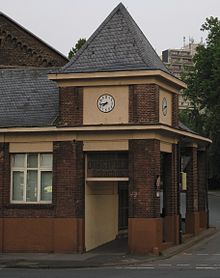Dorstfeld colliery
| Dorstfeld colliery | |||
|---|---|---|---|
| General information about the mine | |||
| Headframe of the Dorstfeld colliery 5/6, 1959 | |||
| Mining technology | Wheel cutting machine | ||
| Information about the mining company | |||
| Operating company | United Dorstfeld Union | ||
| Employees | 3,622 | ||
| Start of operation | 1849 | ||
| End of operation | 1963 | ||
| Successor use | Creativzentrum of the adult education center Dorstfeld | ||
| Funded raw materials | |||
| Degradation of | Hard coal | ||
| Geographical location | |||
| Coordinates | 51 ° 30 ′ 41 ″ N , 7 ° 24 ′ 41 ″ E | ||
|
|||
| Location | Dorstfeld | ||
| local community | Dortmund | ||
| Independent city ( NUTS3 ) | Dortmund | ||
| country | State of North Rhine-Westphalia | ||
| Country | Germany | ||
| District | Ruhr area | ||
The bill Dorstfeld was a coal - mine in Dortmund district Dorstfeld .
history
The sinking of shaft 1 of the Dorstfeld colliery, originally the United Dorstfeld union , began in 1849, and a total of ten shafts were sunk for the mine over time. In 1885, a wheel cutting machine was used for the first time in the Ruhr mining industry. The takeover of the United Carlsglück & Planetfeld colliery in 1889 marked the path to the large mine .
Between 1860 and 1864 the Swedish chemist Alfred Nobel worked at the Dorstfeld colliery, where he experimented with explosives in mining.
At times the mine operated up to three coking plants :
- a coking plant near the Karlsglück shaft
- a coking plant on the Dorstfeld 2/3 mine (1903–1963)
- a coking plant on the Dorstfeld 1/4 mine (1907–1929)
On May 16, 1925, a heavy explosives and coal dust explosion occurred at shaft 5, killing 47.
The largest production volume was achieved in 1939 by 3,622 employees with 1,329,941 tons of coal.
The Dorstfeld colliery was closed in 1963.
Today, the converted chew and administration buildings of the shaft system 2/3, in which the creative center of the adult education center in Dortmund has found a location, the pointed cone heaps near the Revierpark Wischlingen as well as the preserved sludge separator towers of the shaft system 1/4 remind of the Zeche Dorstfeld that are used today for residential purposes. In their vicinity there are other former company buildings, some of which have fallen into disrepair and are located on inaccessible company premises.
The Oberdorstfeld settlement built by the architect Oskar Schwer from Essen in the style of a garden city is also worth seeing and living.
The 2/3 mine was located between Wittener Straße and Vogelpothsweg, its former siding is largely identical to the route of today's S-Bahn line 1. On the site of the coking plant of the 2/3 mine, pollutants such as naphthalene and other coke-type hydrocarbons found. Since some new residential developments had already been built there, the soil had to be removed.
Relics
The relics of the colliery are registered as architectural monuments in the monuments list of the city of Dortmund .
From 1963 on, the previous colliery site was converted into a commercial and industrial area under the name Dorstfeld-West . For this purpose, the area was particularly interesting because of its proximity to the city center and its good road connections. Today the area covers 122 hectares and is home to around 175 companies with around 5,000 employees subject to social security contributions.
literature
- Wilhelm Hermann, Gertrude Hermann: The old mines on the Ruhr. 6th edition, updated by Christiane Syré and Hans-Curt Köster. Langewiesche Nachf. Köster, Königstein im Taunus 2007, ISBN 3-7845-6994-3 .
- Joachim Huske: The coal mines in the Ruhr area. 3rd edition, self-published by the German Mining Museum, Bochum, 2006, ISBN 3-937203-24-9 .
Individual evidence
- ↑ No. A 0291. List of monuments of the city of Dortmund. (PDF) (No longer available online.) In: dortmund.de - Das Dortmunder Stadtportal. Monument Authority of the City of Dortmund, April 14, 2014, archived from the original on September 15, 2014 ; accessed on June 16, 2014 (size: 180 kB). Info: The archive link was inserted automatically and has not yet been checked. Please check the original and archive link according to the instructions and then remove this notice.


